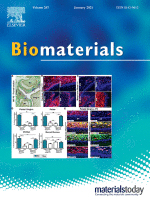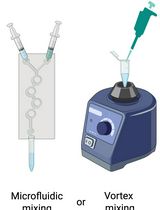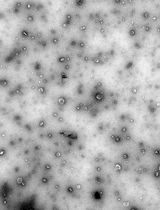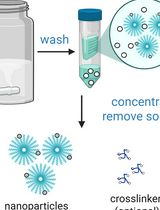- EN - English
- CN - 中文
Preparation and Characterization of IL-22 mRNA-Loaded Lipid Nanoparticles
负载IL-22 mRNA的脂质纳米颗粒的制备与表征
(*contributed equally to this work) 发布: 2023年04月05日第13卷第7期 DOI: 10.21769/BioProtoc.4647 浏览次数: 2313
评审: Oneil Girish BhalalaSrajan KapoorAnonymous reviewer(s)
Abstract
Interleukin-22 (IL-22) has been demonstrated as a critical regulator of epithelial homeostasis and repair; it showed an anti-inflammatory effect against ulcerative colitis. Local microinjection of IL-22 cDNA vector has been shown to be effective in treating ulcerative colitis in mouse models. However, microinjection comes with multiple technical challenges for routine colon-targeted drug delivery. In contrast, oral administration can get around these challenges and provide comparable efficacy. We showed in previous studies that oral administration of new lipid nanoparticles (nLNP)-encapsulated IL-22 mRNA targets the colon region and efficiently ameliorates colitis. This protocol describes the details of preparing and characterizing the nLNP-encapsulated IL-22 mRNA using three major lipids that mimic the natural ginger-derived nanoparticles. It provides an nLNP platform that can be used to orally deliver other types of nucleic acids to the colon.
Keywords: Ulcerative colitis (溃疡性结肠炎)Background
Interleukin-22 (IL-22) is an anti-inflammatory cytokine that plays a critical role in promoting wound healing during intestinal inflammation. Its expression is decreased in inflamed ulcerative colitis tissue (De Souza and Fiocchi, 2016). Microinjection of IL-22 cDNA into the colon of colitic mice showed its potential in curing ulcerative colitis. Targeted delivery of IL-22 cDNA ameliorated local intestinal inflammation through induction of mucus production, enhancing STAT3 activation in colonic epithelial cells and promoting restitution of goblet cells. Additionally, inhibition of IL-22 activity suppressed goblet cell restitution during the recovery phase of the mouse model (Sugimoto et al., 2008).
Despite its effectiveness, microinjection is an invasive technique that requires trained personnel and specific medical equipment. Contrarily, oral delivery is noninvasive and more convenient for patient self-administration. Due to their excellent biocompatibility and drug-loading capability, nanostructured lipid carriers, such as solid lipid nanoparticles and liposomes, have become an attractive oral drug delivery platform that is starting to replace conventional drug delivery systems (Ahadian et al., 2020). However, challenges exist when the delivery system passes through the gastrointestinal tract, including high enzymatic activity and variation in pH and absorption efficiency across the intestinal epithelium.
We previously used ginger-derived lipid nanoparticles (GDNPs) for orally delivering CD98 siRNA (Zhang et al., 2017) and 6-shogaol (Yang et al., 2021) to treat ulcerative colitis. These studies suggested that GDNPs could overcome the challenges of oral drug delivery. Further, we found that monogalactosyl-diacylglycerol (MGDG), digalactosyl-diacylglycerol (DGDG), and phosphatidic acid (PA) constitute more than 90% of the total lipids of GDNPs (Zhang et al., 2016; Zhang et al., 2017). In this protocol, we will describe how to use these three lipids at the same ratios found in the GDNPs in the synthesis of new lipid nanoparticles (nLNPs) to encapsulate IL-22 mRNA. The nLNP-encapsulated mRNA showed its therapeutic efficacy in one of our recently published studies (Sung et al., 2022).
Materials and Reagents
50 mL single-neck recovery flask (Ace Glass, catalog number: 945808)
Micropipettes, 10–100 µL (Eppendorf, catalog number: 13-684-251)
Pipette tips, 1–300 µL (Fisher Scientific, SureOneTM micropoint pipette tips, catalog number: 02-707-410)
Serological pipettes, 5 mL (VWR, catalog number: 89130-886)
Disposable cuvettes (GMBH + Co KG, catalog number: 759075D)
Disposable folded capillary cell (Malvern, Zetasizer Nano Series, catalog number: DTS1070)
20% glucose solution (Gibco, catalog number: A2494001), stored at 4 °C
DEPC water (Invitrogen, catalog number: AM9916), stored at 4 °C
TurboFectTM transfection reagent (Thermo ScientificTM, catalog number: R0531), stored at 4 °C
Monogalactosyl-diacylglycerol (MGDG) (Avanti Polar Lipids, catalog number: 840523), stored at -20 °C
Digalactosyl-diacylglycerol (DGDG) (Avanti Polar Lipids, catalog number: 840524), stored at -20 °C
L-α-phosphatidic acid (PA) (Avanti Polar Lipids, catalog number: 840074), stored at -20 °C
IL-22 pMRNAXP vector (SBI, sequence XM_006513865.4), stored at -80 °C
mRNA synthesis kit (SBI, catalog number: MR-KIT-1), stored at -80 °C
200 proof ethanol (EtOH) (Decon Labs, catalog number: 2401); mix 350 mL of 100% EtOH with 150 mL autoclaved water for a solution of 70% EtOH
Dichloromethane (DCM) (Sigma, catalog number: 40042)
Equipment
Zetasizer Nano-ZS90 (Malvern Instruments Ltd., ZEN3690, serial number: MAL1181172)
Ultrasonicate cleaner (Branson Ultrasonics Corporation, Bransonic®, model: 3510R-MTH)
Rotary evaporator (BUCHI, model: R-210)
Vacuum pump (BUCHI, model: V-700)
Software
Zetasize software 7.12 Copyright© 2002-2016 (Malvern Instruments Ltd.)
Procedure
文章信息
版权信息
© 2023 The Author(s); This is an open access article under the CC BY-NC license (https://creativecommons.org/licenses/by-nc/4.0/).
如何引用
Alghoul, Z., Sung, J., Wu, K., Alpini, G., Glaser, S., Yang, C. and Merlin, D. (2023). Preparation and Characterization of IL-22 mRNA-Loaded Lipid Nanoparticles. Bio-protocol 13(7): e4647. DOI: 10.21769/BioProtoc.4647.
分类
生物工程 > 生物医学工程 > 药物递送
分子生物学 > 纳米颗粒
您对这篇实验方法有问题吗?
在此处发布您的问题,我们将邀请本文作者来回答。同时,我们会将您的问题发布到Bio-protocol Exchange,以便寻求社区成员的帮助。
Share
Bluesky
X
Copy link













